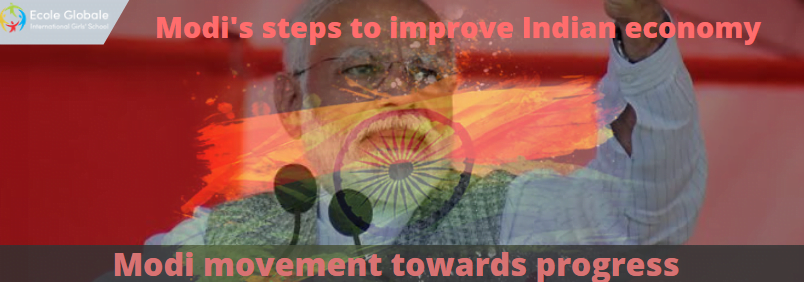On August 30, 2019, the Ministry of Statistics (India) discharged a report that assessed the Gross Domestic Product (GDP) for the principal quarter of 2019-2020, going from April-June 2019. The appraisals indicated that India’s GDP came at 5.0 percent, the most minimal development since Q1 in 2012-2013 when the economy developed at 4.9 percent. The information additionally indicated that the pause was brought about by a deceleration in the manufacturing sector and a reduction of farming yield. Facing this droop in development, what means can the Modi government employ to help boost the development and bring the economy in the groove again? Let’s take a look at the options here-
Steps that Modi’s take to improve the Indian economy
Financial Policy
Following the arrival of the GDP estimates, calls for an expanded financial upgrade to spike development have expanded. Without a doubt, this calls for some financial improvement, an effective boost by the administration. In any case, expanding spending to give a financial boost to the economy may not be that simple for this administration. The administration has its very own budget at a deficit- 3.3 percent of GDP for 2019-2020, not giving many options for the general development because the focus is a lost cause here. In addition, report estimates recommend that public sector borrowings, which incorporate acquiring made by India’s state governments and public ventures and the central government, are in excess of 8 percent. Given these conditions, it is dubious if the administration will have the option to give any important financial improvement to bring the economy on track?
Monetary Policy
Another device that the Modi government can use is related to the monetary policy. A few financial specialists have expressed that, considering the low GDP development numbers, the Reserve Bank of India (RBI) will cut its repo rates by at least 25 basis points (0.25 percent), with banks, for example, Goldman Sachs and HDFC Bank even recommended that the RBI’s Monetary Policy Committee would report cuts in the scope of 40 or 50 basis points (0.4 percent or 0.5 percent).
However, these slices are probably not going to give quick (desired) alleviation to the economy. Niranjan Rajadhyaksha (Research Director and Senior Fellow at IDFC Institute) believes that the boost is given by monetary policies “works with a slack of around seventy-five percent in India, which implies that a rate cut today moves the interest needle nine months after.” Therefore, despite the fact that the government may have more space to provide some upgrade on the fiscal policy front, it may not give the prompt help that the economy may require at this moment.
Basic Reforms
Past the immediate financial and fiscal estimates that the Modi government can employ, the administration ought to likewise consider supplementary changes that, whenever intended to, can release another quick rush of monetary development in India. While the Reserve Bank of India, in its yearly report published on August 29th, expressed that “the ongoing deceleration could be in the idea of a delicate fix changing into a patterned downswing, instead of a profound basic log jam,” it went on to state that “there are as yet basic issues in land, work, farming showcasing and so forth, which should be tended to first.” Given that the pause in the economy is happening over numerous areas – textile, transport, communication, development, horticulture, and land – tending to these basic issues can give shelter to the economy. While at the same time motioning to the market partners a good commission on the part of the Modi government to improve the economy.
Some particular changes for the Modi government to consider-
- Remember to loosening up limitations for land obtaining made by the Land Acquisition Act, 2013
- Discharging significant ports from government endorsement
- Loosening up work laws and
- Guaranteeing progress on key territories where India falls behind on the World Bank’s Ease of Doing Business, for example, “Enlisting Property” and “Authorizing Contracts.”
These are the changes of Modi on the Indian economy. This helps to improve the Indian economy. However, these changes will likewise require long development periods, so the legislature would need to utilize these devices pair with financial and monetary tools, as opposed to independent from anyone else. Following the lull in India’s economy, the Modi government should consider a scope of approach choices on the most proficient methods to react to the slowdown. While there is little hope that the administration could use to turn around this log jam, the government has money related, financial, and auxiliary change devices it can use to stimulate growth boost. While the slowdown made India free its spot as the quickest developing economy on the planet, an opportune and insightful reaction over these three alternative strategies can avoid a further drop, and in any event, bring India’s economy in the groove again. Modi also supports boarding schools in India for better education for small kids. Additionally, the Modi government has many plans to improve economic growth in India, which may take a long time to bring up economic growth but will definitely be in our favor.









